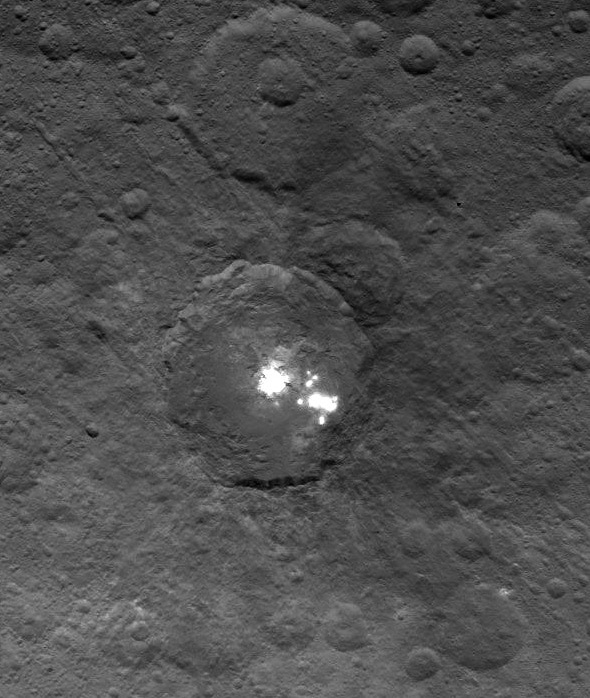Create a free profile to get unlimited access to exclusive videos, sweepstakes, and more!
What the Heck Are Those Spots on Ceres?

The Dawn spacecraft has now dropped down closer to the asteroid Ceres, starting its second surveying mission, and taking its highest resolution images of the world yet. The details are as lovely as they are baffling.
Dawn took a great shot of those weird white spots, and I’m hoping these new images will help astronomers get closer to figuring out what those features are. The crater seen above is about 90 kilometers across. Even from a long way off, Dawn could see the two clusters of white spots in it, and as it approached we could see the spot on the right was made up of smaller, tightly clustered spots.
Now, from its survey orbital height of 4,400 km, Dawn reveals the big one on the left is irregularly shaped. It may also be made up of many small spots blurred together; it’s hard to say.
I’ve always been curious that the big spot seem centered in the crater, but now we have another feature to add: Do you see the dark spray of material to the right of the crater, extending up and down? I fiddled with the contrast a bit in the image above to bring it out. That looks like the pattern you get when an impact happens at very low angle and material splashes out. It’s arc-shaped, and the apex appears to be centered on the crater center.
Interesting.
Mind you, I’m speculating by eyeballing the image. But you can bet every penny you have planetary scientists are poring over these images and examining every detail. These bright spots are unique; no other such high-contrast feature is seen on airless, rocky bodies. We know Ceres has a lot of water ice under the surface, so it’s not too far out to think that may be what we’re seeing. A recent impact could’ve dredged up ice (we’ve seen that on Mars, in far smaller craters), splashing it around the crater, and also caused that darker spray. But right in the exact center of that big crater (which is clearly much older)? That seems like a big coincidence. Could it be from some sort of vent?
Ice on the surface can’t last forever; bombarded by ultraviolet light from the Sun would break it down over time — even just plain old sunlight might sublimate the ice (turn it from a solid into a gas) over the ages.
It’s also possible those spots are salts of some kind, which would alleviate the issue of them being so young. But we still have the same question: Where did they come from?
The good news is that this survey orbit has just begun, and will continue for many weeks. Even better, Dawn will drop into a lower orbit, called the High Altitude Mapping Orbit, in a couple of months, where it will circle Ceres from 1,470 km, and then drop further into its Low Altitude Mapping Orbit, at a height of 375 km, in December. In that last orbit it will have a resolution of 35 meters per pixel, which hopefully will yield very detailed images. And we don’t have to rely on just visible light images. Dawn has a thermal imager (mapping the infrared “heat” signature of the surface), and perhaps most importantly a neutron detector, which can indirectly detect the presence of water. That could resolve (haha) the issue right there once it gets enough data.
The images just released show other interesting features, too. Long chains of secondary craters (created when debris ejected from a big impact flies out and itself impacts the surface), images of landslides and scarps (steep cliffs), and more. The crater with the white spots appears to have been enlarged a bit over time by landslides; the top part of the rim has the characteristic scalloped appearance of collapse, and you can see what looks like debris piled up on the crater floor.
Ceres is over 900 km across, and has a surface area bigger than Texas and Alaska combined. There’s a lot of territory to explore, and I’m very sure a lot of very, very interesting stuff left to discover.














